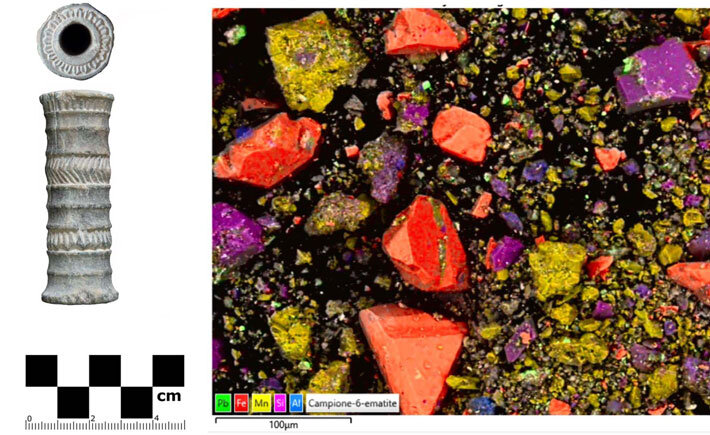3,700-year-old lipstick unearthed in Iran could be oldest ever found

TEHRAN - A fascinating discovery in Iran has unveiled what scientists believe to be a Bronze Age lipstick, possibly the oldest ever found, shedding light on the ancient art of cosmetic adornment dating back to the second millennium BC.
Discovered amidst a cache of artifacts unearthed in the Jiroft region of Kerman province, southeastern Iran, a small chlorite vial has yielded a deep red cosmetic preparation, believed to be a lip-coloring paint or paste.
Recent radiocarbon dating has pinpointed its creation to somewhere between 1936 and 1687 BC, marking it as potentially the earliest lipstick ever analytically reported.
The find not only highlights the ancient Iranians’ penchant for personal adornment but also underscores the longstanding tradition of cosmetology in the region.
While cosmetics like foundations, eye shadows, and black kohl eyeliners have been previously identified in ancient Near Eastern and Egyptian civilizations, the discovery of deep red pigments, akin to those found in lipstick, has remained elusive until now.
Chemical analysis of the residue inside the vial, now resembling a fine purple powder, has revealed a composition predominantly of hematite, renowned for its intense red hue, darkened with manganite and braunite, along with traces of galena, anglesite, and other organic substances.
Furthermore, vegetal fibers found in the ancient cosmetic concoction hint at possible aromatic properties, potentially utilized to scent the lipstick.
Quartz particles, likely from ground sand or crystals, have also been identified, suggesting the inclusion of shimmer – a feature reminiscent of contemporary lipsticks. However, it’s also plausible that the quartz flaked off from the decaying container over time.
The intricately decorated vial stands out from similar objects known to date, suggesting a standardized approach to branding, packaging, and trade of cosmetic products in ancient times, similar to contemporary practices.
Although the identity of the lipstick’s owner remains a mystery, the discovery offers valuable insights into the often-overlooked Bronze Age cosmetics industry.
Professor Massimo Vidale, one of the study authors, highlighted the significance of such findings, stating, “It was a costly expression of luxury that played a crucial role in shaping social interaction in the hierarchies of the early cities.”
The unearthing of this ancient lipstick not only adds a glamorous touch to history but also deepens our understanding of ancient civilizations and their beauty practices.
Heavy flood reveals traces of rich civilization
Until the very early 21st century, no one had ever dreamed that a refined forgotten culture could re-emerge from the sands of a remote and arid region in southeast Iran.
The story started when rounds of heavy flood swept the topsoil off thousands of previously unknown tombs in a Bronze Age cemetery in Jiroft. Arrays of remarkable findings at Jiroft demanded a reassessment of a previous interpretation, based on which Mesopotamia was considered the cradle of civilization.
According to a National Geographic article, a flood of archaeological objects began appearing in the antiquities market seemingly out of nowhere in 2001.
In a short time, distinctive pieces of jewelry, weapons, finely crafted ceramics, drinking vessels, and game boards—featuring unusual artistry and magnificent inlays of carnelian and lapis lazuli found their way to antique markets for sale.
These extraordinary pieces featured a complex symbology of animals, both wild and domesticated, depicted fighting among themselves or with human figures, the humans always triumphant. There were beautifully realized bucolic scenes of animals grazing in vast palm groves and architectural reproductions of temples or palaces.
Data provided by online sites and auction houses selling these mysterious pieces were sparse and, at best, vague. Their origins were often listed as “from Central Asia.”
At first, it was assumed that the pieces were the work of expert forgers, but as more came on the market in the following months, scholars began to speculate that they could be genuine, deriving from an undocumented site whose location was unknown to them. In 2002 more appeared on the market.
Iranian police solved the mystery later that year. A coordinated investigation led to the arrest of several traffickers and the confiscation of a hoard of artifacts. These objects were being prepared to be shipped from Tehran, Bandar ‘Abbas, and Kerman to buyers around the world. Investigators revealed that most of these distinctive pieces could be traced back to a location in the Halil River Valley, about 25 miles south of Jiroft, a remote and peaceful city in southeastern Iran, not far from the Persian Gulf.
The full import of the discovery became clearer after archaeologists made formal surveys of the area and found that this undocumented culture dated back nearly 5,000 years to the Bronze Age.
AM
Leave a Comment